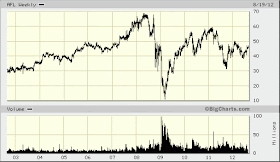Aflac Incorporated (AFL), through its subsidiary, American Family Life Assurance Company of Columbus, provides supplemental health and life insurance. The company is a member of the dividend aristocrats’ index, has paid dividends since 1973 and increased them for 29 years in a row.
The company’s last dividend increase was in October 2011 when the Board of Directors approved a 10% increase to 33 cents/share. The company’s largest competitors include Nippon Life Insurance Company, Asahi Mutual Life Insurance Company and American fidelity Assurance Company.
Over the past decade this dividend growth stock has delivered an annualized total return of 5.20% to its shareholders.
The company has managed to an impressive increase in annual EPS growth since 2002. Earnings per share have risen by 11.60% per year. Analysts expect Aflac to earn $6.53 per share in 2012 and $6.58 per share in 2013. In comparison Aflac earned $4.18/share in 2011.
The company has consistently repurchased stock over the past 7 years, reducing its share count from 516 million shares in 2002 to 468 million in 2012.
The company generates 75% of sales from Japan, with the remainder coming from US operations. Aflac is offering its products in almost 90% of Banks in Japan, and more branches are expected to start pushing the products in the coming years. Aflac steadily increases the number of sales agents in Japan to push its products. Most of its policies offer coverage not insured through Japan’s health care system. As the Japanese population continues aging, the demand for supplemental insurance coverage is expected to grow. The real growth kick could be in the US, where a small portion of US businesses offer Aflac's policies. The fact that Aflac has built a strong brand in the US, based off the white duck, is another strong differentiator. One of the biggest reasons why company's stock is so cheap is probably due to investors' fears of European Bank exposure in Aflac's investment portfolio. The company has started a derisking program over two years ago, which should minimize investment losses.
The return on equity increased from 12.50% in 2003 to 24% in 2010, before decreasing to 16% in 2011. If analysts’ estimates about earnings per share materialize in 2012 and 2013, and there aren't losses from company's investment portfolio, I would see this indicator moving back above 20%. Rather than focus on absolute values for this indicator, I generally want to see at least a stable return on equity over time.
The annual dividend payment has increased by 20.40% per year over the past decade, which is higher than the growth in EPS. This was possible due to the expansion in dividend payout ratio. However, the rate of increase has slowed dramatically over the past five years.
A 20% growth in distributions translates into the dividend payment doubling almost every three and a half years. If we look at historical data, going as far back as 1984 we see that Aflac has actually managed to double its dividend every four and a half years on average.
The dividend payout ratio has doubled from 15% in 2002 to 30% in 2011. A lower payout is always a plus, since it leaves room for consistent dividend growth minimizing the impact of short-term fluctuations in earnings.
Currently, Aflac is attractively valued at 8.40 times earnings, has an adequately covered dividend and yields 2.90%. I would consider adding to my position in the stock subject to availability of funds.
Full Disclosure: Long AFL
Relevant Articles:
- 17 Cheap Dividend Aristocrats on Sale
- Does entry price matter to dividend investors?
- Active Dividend Growth Investing
- Twelve Dividend Machines Boosting Dividends




